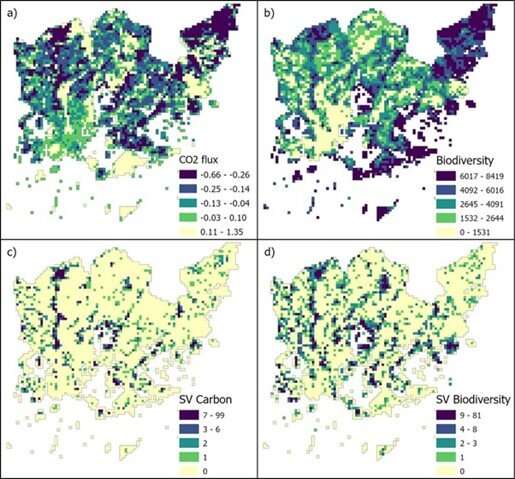This article has been reviewed according to Science X's editorial process and policies. Editors have highlighted the following attributes while ensuring the content's credibility:
fact-checked
trusted source
proofread
Identifying priority areas for nature-based solutions to carbon emissions

Managing the benefits of nature-based solutions across climate, biodiversity and society is of critical importance for meeting targets for climate neutrality and biodiversity restoration targets. Recent studies call for research into the interplay between biodiversity, climate adaptation and mitigation as well as environmental justice outcomes.
Despite the global policy challenges, little is known about how to both assess and weave diverse knowledge systems and values into carbon-biodiversity trade-off assessments especially in urban areas.
The new paper from HELSUS and the CO-CARBON Strategic Research Council project examines the spatial relationships between biophysical and social values for carbon sequestration potential and biodiversity in Helsinki, Finland. Biophysical models demonstrate the biodiversity values of urban nature-based solutions, including urban forests and other types of urban green spaces.
"The study helps urban planning by identifying priority areas for different types of nature-based solution implementation and capacity building initiatives so as to ensure carbon neutral and nature positive futures can be achieved in ways that are socially acceptable to citizens," says professor Christopher Raymond, WP3 leader of CO-CARBON.
"More specifically, these results inform the implementation of the City of Helsinki's new Forest Management Strategy, which is grappling with the conflicting pressures of conservation and development. For example, increasing planned diversity in forested areas, allowing forests to age naturally and involving the local community in new management actions to adapt to climate change and the impact of a growing city."
The paper was published in the journal npj Urban Sustainability.
Considering social acceptability can inform success in preferable outcomes
The used approach combines methods from carbon sequestration modeling, experts scoring approaches to biodiversity assessment and public participation geographic information systems. The results indicate strong spatial associations between modeled biodiversity and carbon sequestration priorities, but weaker associations between these modeled values and citizen's values for biodiversity conservation and carbon mitigation.
"We are concerned that climate mitigation, adaptation and biodiversity assessments drawing on biophysical assessments alone will be challenging to implement unless they draw upon social factors," says professor Raymond.
Integration of social and biophysical values leads to multiple pathways for protection of nature-based systems to achieve carbon mitigation and biodiversity outcomes. There are also open options for the targeting of education and capacity building programs to areas of local concern.
More information: Christopher M. Raymond et al, Identifying where nature-based solutions can offer win-wins for carbon mitigation and biodiversity across knowledge systems, npj Urban Sustainability (2023). DOI: 10.1038/s42949-023-00103-2
Provided by University of Helsinki




















